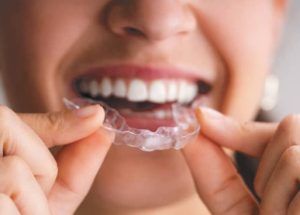By Dr. Amanda Rizner
 Orthodontic aligners have recently become a popular choice for teeth straightening and offer a host of benefits compared to traditional braces. These clear, removable trays have revolutionized orthodontic treatment, providing patients with a discreet, comfortable, and convenient option for achieving a straighter smile.
Orthodontic aligners have recently become a popular choice for teeth straightening and offer a host of benefits compared to traditional braces. These clear, removable trays have revolutionized orthodontic treatment, providing patients with a discreet, comfortable, and convenient option for achieving a straighter smile.
Aesthetics
One of the most prominent advantages of orthodontic aligners is their nearly invisible appearance. Unlike traditional braces which feature metal wires and brackets, aligners are made of a transparent plastic material. This discretion makes them particularly appealing to adults and teenagers who may feel self-conscious about wearing braces. Instead of placing metal brackets to help move the teeth, dentists can place a limited number of “composite attachments.” These attachments are composed of the same material as tooth-colored fillings and are often invisible and easily removable. The trays can be easily inserted and taken out for a short period of time for any occasion the patient may have in order to optimize their smile while in treatment.
Removability
Aligners are designed to be removable, allowing patients to take them out for eating, drinking, brushing, and flossing. This flexibility means there are limited dietary restrictions, as there’s no risk of damaging the aligners by consuming certain foods. Patients still need to be cautious with their composite attachments, as they can come off with very hard foods. This benefit of the aligner therapy also allows for better home care. White spot lesions (which are the beginning of cavities) are less common with aligner therapy since patients can remove the trays to practice better hygiene. Their wireless configuration allows the patient to floss easily, preventing decay between teeth. Clear aligners reduce the risk of gum irritation, inflammation, and sores commonly associated with traditional braces. The absence of metal brackets and wire tend to be kinder to the soft tissue over time.
Comfortability
Aligner treatment typically requires fewer visits to the orthodontist compared to traditional braces. Patients are provided with multiple sets of aligners in advance and instructed to change them at home according to a predetermined schedule. This convenience is particularly advantageous for individuals with busy lifestyles who may struggle to accommodate frequent orthodontic appointments.
Bite Correction
Aligners not only help to straighten teeth, but they also aid in correcting a patient’s malocclusion (the way the teeth come together). An uneven bite distribution can lead to tooth mobility, fracture, and eventual tooth loss. Malocclusions can cause eventual issues with the TMJ (temporomandibular joint) and can lead to tooth grinding if not corrected in a timely manner. Orthodontic therapy can also correct cross-bites and midline misalignments.
Conclusion
Not every patient is candidate for this type of treatment. Despite all the advances in clear aligner therapy the past few years, traditional braces are still needed for select cases. Patients who have large skeletal malformations or significant crowding/spacing may still need traditional brackets and wires in order to move the teeth properly and efficiently. It is imperative to have each case carefully assessed by a professional in order to see which type of orthodontics is right for each person. It is also crucial to make sure all cavities and any gum disease is treated before beginning aligner therapy. With proper case planning and evaluation, clear aligners can be a very effective and aesthetic form of orthodontic treatment that many patients have grown to love.
CALL OUR OFFICE TODAY!
(941) 529-0055
www.dentistryonfruitville.com
 Southwest Florida's Health and Wellness Magazine Health and Wellness Articles
Southwest Florida's Health and Wellness Magazine Health and Wellness Articles

